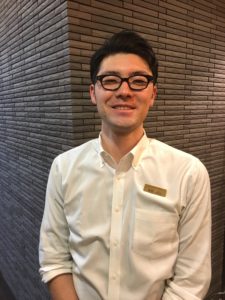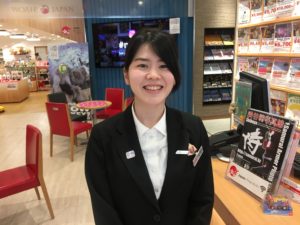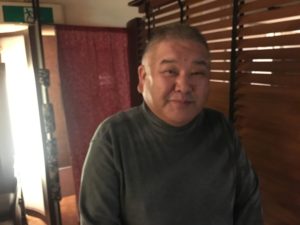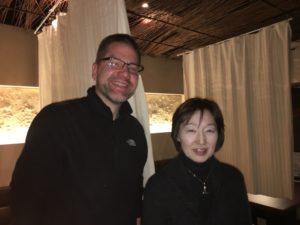I remember when I first arrived in Osaka and got onto the train and felt like the town went on forever. Tokyo makes Osaka look like a dwarf.
I took a bus from Fuji to Tokyo, and it took us nearly an hour when we hit the outskirts of Japan’s capitol city to reach the station downtown.
Obviously, you could spend a week or two just in Tokyo and still not see all of it. I spent a day, and it was a really great experience.
I started with the famous Tsukiji fish market (I had seen Anthony Bourdain go there in his show and was intrigued). The market was a perfect choice. It took a massive city and made it feel like a small town. There were a lot of natives and gaijin tourists wandering through the alleys, taking pictures, trying different delicacies.
Sometimes the fishmongers would quietly stand in front of their catches, their arms folded and faces stoic. Sometimes they would call like barkers in a Tom Waits’ song, inviting the crowd that flowed by their stations to step right up. Or sometimes they would be busily cutting or salting the next piece of fish to hit the ice.
My mother was not an overindulgent woman, but there were two foods that she simply could not resist–oysters and strawberries. I found both in the market, and I indulged while thinking of Stella.
When I finally left the market, I had no idea where I was going. Tokyo rushed around me, a swarm of cars and suited businessmen and women panting beneath their medical masks as they dashed to the next spot in their day. I walked slowly, taking it all in, allowing the city to show me what she wanted to show me.

Takeharu provided me with a shave and a haircut at Barbier Grand Ginza.
What I found was the Kabuki theater. I thought that would be a great way to experience the Edo of the past, but the performance wouldn’t start for another 90 minutes. So, I remained in the Tokyo of today and wandered a little more until I saw something familiar–the swirling candy cane of a barbershop.
I had gotten a wonderful haircut in a Osaka, and I decided that I would clean up a bit before Kabuki. One of the things that the Japanese take very seriously and do very well is hair care for men. Takeharu at Barbier Grand Ginza made me feel like a daimyo of old as he trimmed my hair and gave me a shave.
When I got back to the theater, the first performance had just begun. Now, if you haven’t experienced kabuki before, here’s what I learned. The full show is about 4 hours and takes place in three acts, which are not always a continuous storylines. So, you could just go see a one act play that will take usually around 90 minutes.
That’s what I did. I watched a show called “Description of a Wise Ruler’s Conduct,” a play about a samurai who kills a hunter who shoots a bird in an area where hunting is forbidden. The samurai asks the lord of Okayama Castle, Ikea Mitsumasa, to pass judgment on him.
While I didn’t understand the dialogue, I could understand the tone. But, more importantly, I got to watch the audience respond to the play.
It was a packed house. I was on the 4th floor, and I was standing. Secondly, there were moments when the audience would laugh or gasp, like in western theater, but there were also moments when the audience would shout encouragement to the actor, calling him by his stage name.
While I watched only one play, I noticed that there wasn’t a lot of physical action on stage, but there was a lot of dialogue. This meant that when a character did move that it was extremely important. (I wish that my daughter could have been there to see it. She’s a theater major in college and would have enjoyed it.)

Mariko works in the Tokyo Tourist Information Center. She helped direct me to the Imperial Palace grounds.
After my experience at the theater, I visited the Tsukiji Hongwanji, a beautiful Buddhist temple located very close to the fish market. While I was there, I learned that the Imperial Palace grounds were about a twenty minute walk from my location. I started to make my way there.
On the way, I saw the Tokyo Tourist Information Center and decided to go in. I met a young woman named Mariko, who had lived in Oregon for a year as a foreign exchange student. She grew up near Tokyo has been working for JTB for about a year.
“I like to be able to share Japanese culture with people who are interested in learning about it,” she said.
Mariko told me that when she was in Oregon she shared the Japanese tea ceremony with the Americans with whom she was staying.
After speaking with Mariko, I headed a few more blocks to the Imperial Palace grounds. While I wasn’t able to visit the palace itself, it was nice to walk amongst the vast field of pine trees that had been manicured like they were large scale banzai trees.

Hirofumi is the owner of Bunpachi Restaurant, and he was a wonderful host to Rumi and myself.
I had spent most of the day walking and headed back to the hotel to rest before meeting Rumi Takeda for dinner that evening. When I was in Germany, I stayed with the O’Connor family. Judy is half Japanese, and Rumi is her cousin.
We initially planned to eat sushi, but I had had my fill of fish earlier that day. So, we opted for a restaurant close to my hotel that specialized in wagyu beef. It was a great experience for a couple of reasons. First, Rumi is trying to learn English, so we got to spend a couple of hours practicing our communication skills as we talked. Secondly, the owner of Bunpachi, Hirofumi Nakano, was on hand and actually came over to our table a number of times to check on us and to explain how to enjoy wagyu.
At the center of our table was a mini-grill. The chef would come out with a plate of the different cuts of beef and then cook the initial portion. I quickly realized that he was showing us the process and that we were expected to cook the remaining portions. I love to cook, so it was a real treat for me.

Rumi was my dinner guest at Bunpachi where we enjoyed from great wagyu beef and conversation.
Rumi and I talked about being parents (she has three daughters), and she told me about the challenges she faced raising her children in Tokyo, which is a huge city.
When her daughters were young (they’re all adults now), Rumi would ride her bicycle with them. She would have one daughter on the front of the bike, one of the back of the bike, and the last one strapped to her back.
“It was like circus,” she said with a laugh as she held hands up like she was gripping the handlebars and made a wobbly motion with her who body.
I had been quite nervous about Tokyo’s size and population, but my day in Japan’s capitol was one that involved more personable interactions, culminating in my evening with Rumi. It was a wonderful way to experience the Edo of the past and the Tokyo of the present.
Until my next post, keep looking to the heavens and seeking your own star.
